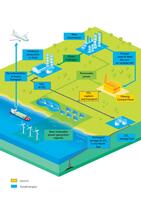- The project will capture, utilize, and sequester 1.3 million metric tons of CO2 annually.
- An air-oxyfuel switchable kiln will be used to facilitate CO2 capture and purification.
- Captured CO2 will be used for e-fuel production or stored in the North Sea.
- A new electrolyzer powered by renewable energy will generate green hydrogen for the process.

Project Overview
TotalEnergies and Holcim have signed a Memorandum of Understanding (MoU) to fully decarbonize a cement production facility in Obourg, Belgium. The project aims to capture, utilize, and sequester (CCUS) approximately 1.3 million metric tons of CO2 emitted annually by the facility.
Technological Contributions
Holcim will upgrade the current cement plant with an innovative air-oxyfuel switchable kiln to facilitate the capture and purification of CO2 in the flue gases. TotalEnergies will handle the transportation and use of the captured CO2 for e-fuel production or geological storage in the North Sea.
Renewable Energy Integration
TotalEnergies plans to develop renewable energy projects to power a new electrolyzer, which will generate green hydrogen needed for e-fuels. This renewable energy will also power Holcim’s new oxyfuel kiln, contributing to the plant's decarbonization. The oxygen produced by the electrolyzer will be used to fuel the new kiln.
Strategic Importance
The collaboration aims to make the Obourg facility the first net carbon-neutral clinker plant in northwest Europe. This initiative is part of a broader strategy to set new standards for future clinker manufacturing plants and to address the hard-to-abate emissions in the cement industry.

